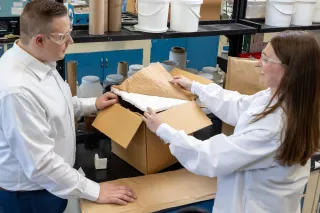Climate change, biodiversity loss, and sustainability thinking drive biomaterial research and development at VTT. PHA polymers, protein-based biomaterials, and even fungal mycelia originating from nature are used to find alternatives for traditional, environmentally harmful production methods and fossil-based materials. These materials are now being developed faster and more securely than before with the help of AI.
Read the summary
- Key focus areas include biosynthetic materials like PHA polymers, fungal mycelia, and protein-based materials, all with diverse applications and the ability to be produced from industrial by-products.
- Technological advances, including AI, enhance the development process by predicting material properties, improving bioprocesses, and speeding up solutions without extensive laboratory testing.
- Challenges remain, such as investment needs and production costs, but VTT aims to overcome these to revolutionise industry and contribute to a more sustainable future.
This summary is written by AI and checked by a human.
As the climate crisis continues to accelerate, the need for microplastic-free materials made from renewable sources has become critically important. Bio-based materials, materials from nature, or materials produced through biological processes offer a promising alternative to traditional plastics and synthetic compounds.
“At VTT we work on biopolymers that can be grown or produced using microbes. These so-called ‘biosynthetic materials’ are produced in bioreactors by fermentation, using the natural biochemistry within microbes. As this process can increasingly be controlled at the molecular and process levels, microbes can thus be harnessed for the industrial production of tailored material components”, explains VTT Senior Scientist Géza Szilvay.
Biosynthetic materials do not offer a particular solution but rather a quickly growing palette of material types that vary in their properties, origins, and applications. They all share one common factor: a drive toward a more ecological world that follows the principles of the circular economy and, in the future, also toward new, tailored material functionalities.
Technological leaps in the field of biotechnology hasten the development and introduction of biosynthetic materials. These leaps include, for instance, the development of computational methods and the growth in computing power, advances in sequencing, synthesis, and the ability to modify DNA more effectively than ever before, as well as the automation of sophisticated screening and fermentation processes.
These advancements offer an even better understanding of what happens inside the microbes and thus enables their modification in a desired manner. The development of processes and scaling up from the laboratory to the industrial scale is also faster than before.
From fungal mycelia to PHA polymers and protein-based materials
Within the field of biosynthetic materials VTT has decided to focus on materials developed from PHA polymers, proteins, and fungal mycelia. The palette is completed by enzymes that can be used to tailor and produce biobased polymers.
“We see potential for growth in these very material types, particularly for two reasons. First, they can be biotechnologically produced from industrial side streams, even from CO2 emissions. Secondly, the chemical and structural diversity of these molecules is so vast that even natural evolution has not had the time to explore all the possibilities”, Szilvay continues.
The challenge researchers face is finding the technologically most relevant functionalities from a large number of possibilities.
“There are numerous materials and polymers in nature that are astonishingly high performing, but, as such, they might not be suitable for industrial production processes. Therefore, we are developing tools for finding the right polymers that fit to a specific application and process”, says Szilvay.
Fungal mycelium is a fibrous network that in nature lives for example in soil, but under controlled conditions it can be cultivated using, for example, agricultural side streams to make composite materials. When dried and compressed, the mycelium forms a lightweight, strong, and fully biodegradable material. Mycelium applications range from building materials to design products and leather-like fabrics.
PHA polymers, in turn, are polyesters produced by microbes with properties similar to synthetic plastics. However, they are fully biodegradable, recyclable, and do not generate persistent microplastics. They are also biocompatible, making them well-suited for medical applications. PHA production is based on fermentation processes, in which bacteria convert organic substances or CO2 into polymers.
Biotechnologically produced proteins can be used to create fibres, coatings, or composite materials. Application areas include biomedicine, textiles, and skin and hair care products. For example, biosynthetic spider silk protein is used in skincare products as well as fibres for textiles. The advantages of biosynthetic protein materials lie in their natural biocompatibility and the ability to incorporate functionality. Additionally, by modifying the protein structure, material properties can be fine-tuned, and new functionalities can be introduced to suit specific applications.
AI speeds development
Developing bio-based materials has traditionally required plenty of laboratory work, experimentation, and time-consuming testing. Now, AI and computational methods are speeding up processes and bringing new tools with them, which accelerate the design of biosynthetic materials and, thus, the discovery of new applications.
“One of the most significant roles of AI is in the prediction of polymer properties and material characteristics by utilizing computational models and experimental data. AI acts as an accelerator in biomaterial development. On the other hand, with the rise of robotics, AI can increasingly be utilized to improve bioprocesses and thereby reduce production costs," Szilvay says.
"We hope that in the future, with the help of AI, we can directly develop desired solutions with less time-consuming experimentation," Szilvay adds.
Though the potential of biosynthetic materials is vast, before their larger introduction, there are several challenges that need to be solved. The main hurdles include investments required for production scale up and the yet higher production costs compared to synthetic materials.
Biosynthetic materials are breakthrough technologies essential for fully realizing the potential of the circular economy: instead of using natural resources in a linear way, the aim is to build closed systems in line with circular economy principles, where materials return to nature's cycle or are reused. VTT seeks to use these materials to renew the industry and open novel pathways toward more sustainable production.
Pictures: Manuel Arias Barrantes





